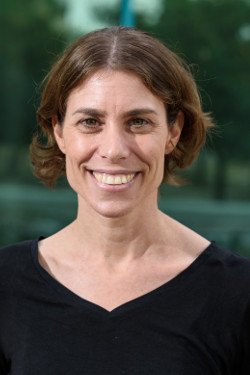Michal Rivlin
2019 Israel Award Winner — Faculty

Current Position:
Senior Scientist and Sara Lee Schupf Family Chair
Institution:
Weizmann Institute of Science
Discipline:
Neuroscience

Current Position:
Senior Scientist and Sara Lee Schupf Family Chair
Institution:
Weizmann Institute of Science
Discipline:
Neuroscience
Recognized for: The paradigm-shifting discovery that cells in the adult retina can exhibit plasticity in their selectivity and computations.
Areas of Research Interest and Expertise: Neuronal Plasticity, Retinal Biology, Electrophysiology, Computational Neuroscience, Visual Processing
Biography:
BSc, The Hebrew University of Jerusalem
PhD, The Hebrew University of Jerusalem (Advisor: Prof. Hagai Bergman)
Postdoctoral Fellow, University of California, Berkeley, USA (Advisor: Prof. Marla Feller)
Dr. Michal Rivlin’s groundbreaking work has led to a paradigm shift in our understanding of the retina. Light, reflected off objects in our field of vision, is first processed by a complex network of retinal neurons, and the processed information is conveyed to the brain by retinal ganglion cells (RGCs), the retina’s output neurons. RGCs are composed of various types, and each encodes a specific property in the visual image, such as subtle changes in light levels, the edges of an object, or even motion. This variety provides the basis for the amazing complexity of our visual experience. Most neuroscience textbooks will tell you that the computations performed by RGCs are fixed; for example, an RGC that responds to an object moving from right to left will always have that directional selectivity, never responding to an object moving from left to right. However, Dr. Rivlin has shown that such selectivity can be altered, even in adult animals where all neural circuits are thought to be less adaptable, or “plastic”. She found that direction-selective RGCs can change their directional tuning after repetitive stimulation, and that RGCs tuned to detect increases in illumination can change their preference to instead detect decreases in illumination. Not only is this one of the first demonstrations of adult functional neuronal plasticity outside of the brain, but it raises fundamental questions about how we see. If retinal processing is actually dynamic rather than fixed, how do neurons downstream from the retina interpret this dynamic code, and how do we still emerge with a consistent representation of our visual world?
“Years ago, the retina was treated as a simple camera, sending pixel-like information to the brain, which conducts all the complex computations on the visual field. Today we understand that the retina can perform myriad computations, splitting the visual information into multiple parallel pathways, each conveying information on a specific visual property. Our finding that retinal neurons can dynamically change the visual property they encode implies that the retina may perform higher order computations. My lab has two goals: to decipher the mechanisms that allow retinal neurons to dynamically change their function, and to understand how, despite the changes in retinal computations, we preserve our visual perception. I am honored to join the Blavatnik award Laureates, a selected group of groundbreaking young scientists who dare to challenge the conventions.”
Key Publications:
R.A. Warwick, N. Kaushansky, N. Sarid, A. Golan, M. Rivlin-Etzion. Inhomogeneous encoding of the visual field in the mouse retina. Current Biology, 2018.
M. Rivlin-Etzion, W. Grimes, F. Rieke. Flexible neural hardware supports dynamic computations in retina. Trends in Neuroscience, 2018.
A.L. Vlasits, R. Bos, R.D. Morrie, C. Fortuny, J.G. Flannery, M.B. Feller, M.Rivlin-Etzion. Visual stimulation switches the polarity of excitatory input to starburst amacrine cells. Neuron, 2014.
M. Rivlin-Etzion, W. Wei, M.B. Feller. Visual stimulation reverses the directional preference of direction selective retinal ganglion cells. Neuron, 2012.
Other Honors:
| 2014 | The Peter and Patricia Gruber International Research Award, The Gruber Foundation and The Society for Neuroscience |
| 2010-2013 | Long-Term Fellowship, Human Frontiers Science Program |
| 2009 | Postdoctoral Fellowship, Edmond and Lily Safra Foundation |
| 2009 | National Postdoctoral Award Program for Advancing Women in Science, Weizmann Institute of Science |